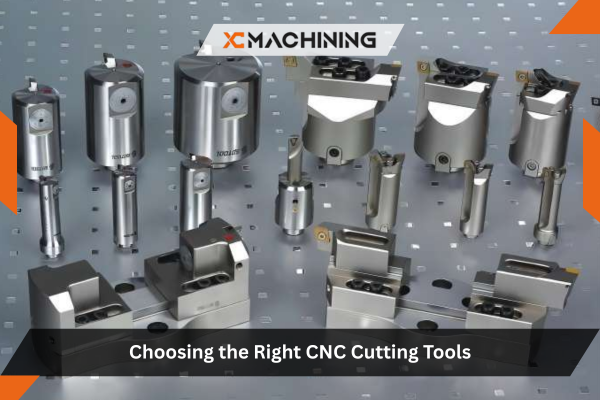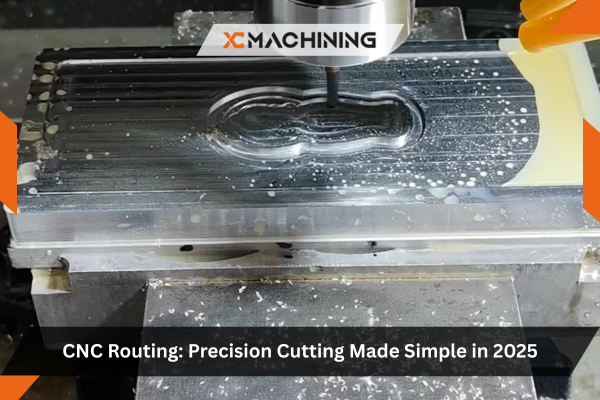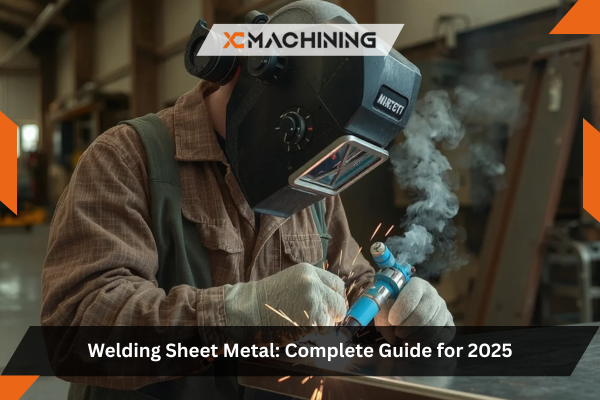The performance of any CNC machining operation ultimately depends on one critical factor: the cutting tools removing material from the workpiece. Even the most advanced CNC machine cutting tools become ineffective when paired with inappropriate tooling, while the right tool selection transforms basic equipment into precision manufacturing systems. Whether you’re machining aerospace components from titanium alloys, producing automotive parts from aluminum, or fabricating industrial equipment from stainless steel, understanding CNC cutting tools their types, materials, geometries, and selection criteria separates successful machining operations from those plagued by poor surface finish, excessive tool wear, and dimensional inaccuracies. This comprehensive guide examines the essential knowledge needed to select optimal cutting tools for diverse machining applications, helping machinists, manufacturing engineers, and production managers maximize productivity while maintaining quality standards.
Table des matières
Understanding CNC Cutting Tool Fundamentals
Before exploring specific tool types and selection criteria, it’s important to understand what defines a cutting tool and how it functions in material removal processes. CNC cutting tools are precision-engineered implements designed to remove material through controlled mechanical action, creating chips as the tool’s cutting edge engages the workpiece at specific speeds and feed rates.
Every cutting tool, regardless of type, consists of several key elements that determine its performance characteristics:
Cutting edge: The sharp intersection of two surfaces that actually penetrates and shears material. Edge geometry—including rake angles, clearance angles, and edge radius—profoundly affects cutting forces, heat generation, and tool life.
Tool body: The structural mass providing rigidity and supporting the cutting edge. Body design influences vibration damping, thermal management, and overall tool strength.
Shank or mounting interface: The portion that connects the tool to the machine spindle, whether through direct mounting, collets, end mill holders, or quick-change systems. Interface precision directly affects runout and machining accuracy.
Flutes or chip spaces: Channels providing pathways for chips to evacuate from the cutting zone. Flute design affects chip flow, cutting forces, and cooling efficiency.
Understanding these fundamentals provides context for evaluating the best cutting tools for CNC machining across different applications and materials.
Major Types of CNC Cutting Tools
The types of Outils de coupe CNC available reflect the diverse operations performed in modern machining centers. Each category serves specific functions and offers unique capabilities.
Fraises en bout
End mills represent the most versatile and commonly used CNC milling cutting tools, capable of performing face milling, slotting, profiling, contouring, and pocketing operations.
Common end mill variations:
Square end mills: Feature flat bottoms creating 90-degree corners, ideal for slots, pockets, and general machining operations. Available in 2-flute through 8-flute configurations balancing chip evacuation and surface finish.
Ball nose end mills: Hemispherical tips enable 3D contouring and complex surface machining. Essential for mold making, aerospace components, and sculptured surfaces where traditional flat tools cannot reach.
Corner radius end mills: Rounded corners instead of sharp 90-degree edges provide greater strength, longer tool life, and better surface finish. The radius prevents chipping at corners while maintaining near-square geometry.
Roughing end mills: Also called “hog mills,” these tools feature serrated cutting edges creating interrupted cuts that break chips efficiently. Excellent for rapid material removal in roughing operations before finishing passes.
Finishing end mills: Optimized geometries and multiple flutes produce superior surface finishes. Variable helix designs minimize vibration for excellent surface quality in finishing applications.
Moulins à facettes
Face mills machine flat surfaces through peripheral cutting edges, producing excellent surface finish and flatness across wide areas. These CNC cutting tools handle heavy cuts efficiently, making them ideal for removing substantial material from large surfaces.
Modern face mills utilize indexable carbide inserts replaceable cutting edges that reduce tooling costs compared to solid tools requiring complete replacement when worn. Insert versatility allows machinists to change cutting edge geometry, grade, and coating without replacing entire tool bodies.
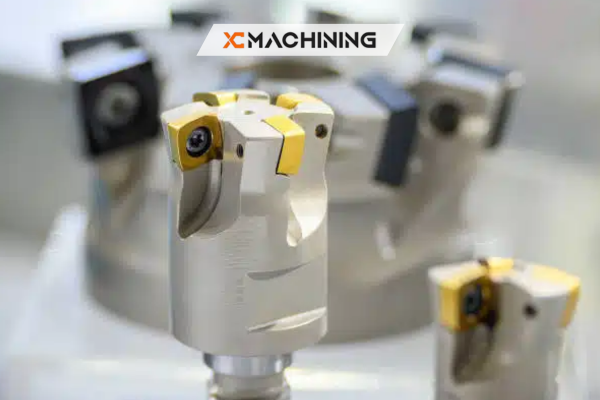
Exercices
Despite their apparent simplicity, modern CNC drilling tools incorporate sophisticated geometries optimizing performance:
Jobber drills: General-purpose drills suitable for most applications with length-to-diameter ratios around 10:1.
Stub drills: Shorter, more rigid designs for shallow holes requiring maximum accuracy and minimal deflection.
Parabolic drills: Deep flutes provide excellent chip evacuation for deep hole drilling applications.
Carbide drills: Solid carbide construction enables higher speeds and feed rates than high-speed steel, particularly in cast iron and non-ferrous materials.
Indexable insert drills: Replaceable insert technology extends to drilling, offering economy in larger diameter applications.
Alésoirs
Reamers produce precision holes with tight tolerances and superior surface finish after drilling. These CNC machine cutting tools remove minimal material typically 0.005-0.015″ but achieve significantly better accuracy and surface quality than drills alone.
Thread Mills
Thread milling tools create internal or external threads through helical interpolation a significant advantage over taps that risk breakage and workpiece damage. Single-point thread mills produce multiple thread sizes with one tool, while multi-form thread mills cut complete threads in single passes.
Outils d'alésage
Boring bars and heads enlarge existing holes to precise diameters with exceptional concentricity and surface finish. Adjustable boring heads enable fine diameter tuning, critical for precision bearing fits and close-tolerance assemblies.
Chamfer and Countersink Tools
These specialized CNC cutting tools create beveled edges, countersinks for fasteners, and deburring operations. Multi-angle tools perform multiple operations simultaneously, improving efficiency.
Cutting Tool Materials: The Foundation of Performance
Tool material selection fundamentally determines cutting speed, feed rate, tool life, and application suitability. Understanding available materials helps identify the best cutting tools for CNC machining specific workpiece materials.
High-Speed Steel (HSS) Tools
HSS represents the traditional cutting tool material offering good toughness, reasonable hardness, and economical pricing. While largely superseded by carbide for production machining, HSS remains valuable for:
- Low-speed manual operations
- Applications requiring extreme edge toughness
- Complex form tools where carbide grinding costs become prohibitive
- Small shops with limited budgets
Cobalt-enhanced HSS (typically 5-8% cobalt) improves hot hardness and wear resistance, extending capabilities into stainless steel and difficult materials while maintaining HSS’s toughness advantage over carbide.
Carbide Cutting Tools
Carbide dominates modern Découpe CNC tools due to its exceptional hardness, allowing cutting speeds 2-10 times higher than HSS while maintaining superior wear resistance. Tungsten carbide particles bonded with cobalt create a material that revolutionized metalcutting productivity.
Carbide grades balance competing properties:
Fine grain carbide: Smaller carbide particles (submicron to 1 micron) create harder, more wear-resistant tools suited for finishing operations and abrasive materials. Increased brittleness requires careful application.
Medium grain carbide: Balanced properties for general-purpose machining. Most CNC milling cutting tools utilize medium grain carbide providing good combinations of hardness, toughness, and wear resistance.
Coarse grain carbide: Larger carbide particles (2-6 microns) increase toughness at the expense of hardness, better resisting chipping in interrupted cuts and roughing operations.
Coated Carbide Tools
Surface coatings applied through physical vapor deposition (PVD) or chemical vapor deposition (CVD) dramatically extend carbide tool life and enable higher cutting parameters. Common coatings include:
TiN (Titanium Nitride): Gold-colored coating improving wear resistance and reducing friction. General-purpose enhancement for moderate speed increases.
TiCN (Titanium Carbonitride): Blue-gray coating offering better hardness and wear resistance than TiN. Excellent for machining cast iron and alloy steels.
TiAlN (Titanium Aluminum Nitride): Violet-bronze coating with excellent hot hardness and oxidation resistance. Superior for high-speed machining generating substantial heat.
AlTiN (Aluminum Titanium Nitride): Similar to TiAlN but optimized composition for extreme temperature applications. Forms protective aluminum oxide layer at high temperatures.
Diamond-like Carbon (DLC): Extremely low friction coating ideal for aluminum and non-ferrous materials preventing built-up edge formation.
Multi-layer coatings combine different materials optimizing multiple performance characteristics simultaneously—wear resistance, lubricity, thermal barrier properties, and chemical stability.
Superhard Materials
PCD (polycrystalline diamond) and CBN (cubic boron nitride) tools represent the apex of cutting tool technology, justifying their high costs through exceptional performance in specific applications:
PCD tools excel in non-ferrous materials including aluminum alloys, copper, brass, composites, and abrasive materials like carbon fiber reinforced plastics. Diamond’s extreme hardness and low friction enable tool life 10-100 times longer than carbide in suitable materials. However, diamond reacts with ferrous materials at cutting temperatures, precluding use in steel machining.
CBN tools machine hardened steels (45 HRC and above), cast irons, and superalloys where extreme hardness and hot hardness exceed ceramic capabilities while providing better toughness. CBN turning inserts machine bearing races, gear teeth, and hardened components previously requiring grinding operations.
Tool Geometry Considerations
Beyond material selection, cutting tool geometry profoundly affects performance. Understanding key geometric parameters helps select optimal CNC cutting tools for specific applications.
Angle de l'hélice
Helix angle describes the twist of flutes around cylindrical tools, affecting cutting action and chip evacuation:
Low helix (15-25°): Reduced cutting forces benefit rigid workholding situations and harder materials. Less aggressive cutting action reduces chatter risk.
Standard helix (30-35°): Balanced performance for general machining. Most standard end mills utilize 30° helix providing good combinations of cutting efficiency and tool strength.
High helix (40-45°): Aggressive cutting action with excellent chip evacuation. Preferred for aluminum and soft materials where chip packing concerns exist. Higher cutting forces require secure workholding.
Variable helix: Unequal flute spacing breaks up harmonic vibrations, dramatically reducing chatter in challenging applications. Premium CNC milling cutting tools often incorporate variable helix geometry.
Flute Count
Number of flutes directly affects material removal rate, surface finish, and chip evacuation:
2-flute end mills: Large flute spaces provide excellent chip evacuation in deep slotting and pocketing operations, particularly in aluminum and plastics where chip volume is high.
3-flute end mills: Balanced design improving surface finish over 2-flute tools while maintaining good chip clearance. Versatile for various materials and operations.
4-flute end mills: Standard for general steel machining. Additional cutting edges improve surface finish and enable higher feed rates. Reduced flute space may cause chip packing in deep cuts or soft materials.
5+ flute end mills: Finishing tools where minimal material removal and maximum surface quality matter most. Limited chip space restricts depth of cut but multiple edges produce superior finishes.
Rake and Clearance Angles
Rake angle the orientation of the tool face relative to the workpiece affects cutting forces and chip formation. Positive rake angles create sharper cutting action with lower forces, ideal for soft materials and finishing. Negative rake angles strengthen cutting edges, better resisting chipping in hard materials and interrupted cuts.
Clearance angle prevents the tool’s trailing edge from rubbing the machined surface. Insufficient clearance causes excessive heat and poor surface finish, while excessive clearance weakens cutting edges.
Workpiece Material Considerations
Material being machined fundamentally determines appropriate CNC cutting tools. Different materials present distinct challenges requiring tailored tool selections.
Aluminum and Non-Ferrous Metals
Aluminum’s softness and tendency toward built-up edge formation requires:
- Sharp cutting edges with highly polished flute surfaces
- Large flute spaces accommodating voluminous chips
- High helix angles (40-45°) for efficient cutting
- PCD tools for high-volume production
- Uncoated or DLC-coated carbide preventing aluminum welding to tool surfaces
Carbon and Alloy Steels
General steel machining benefits from:
- TiAlN or AlTiN coated carbide tools
- Medium to fine grain carbide substrates
- Standard helix angles (30-35°)
- 4-flute end mills for balanced performance
- Positive rake angles reducing cutting forces
Acier inoxydable
Stainless steel’s work-hardening tendency and low thermal conductivity demands:
- Sharp cutting edges minimizing work hardening
- Tools with chip-breaker geometries preventing long stringy chips
- TiAlN coatings providing thermal protection
- Reduced cutting speeds compared to carbon steel
- Adequate coolant preventing heat buildup
Fonte
Cast iron’s abrasiveness requires:
- Wear-resistant coatings (TiCN particularly effective)
- Sharp cutting edges for clean chip formation
- Compressed air for chip evacuation (cast iron machines dry)
- Higher cutting speeds enabled by carbide’s hardness
Titanium Alloys
Titanium’s extreme properties (low thermal conductivity, chemical reactivity, work hardening) make it among the most challenging materials:
- Very sharp cutting edges essential
- Slow cutting speeds (50-150 SFM typical)
- Heavy coolant preventing thermal damage
- Specialized tool geometries developed specifically for titanium
- Frequent tool changes as wear accelerates rapidly
Hardened Steels
Materials above 45 HRC require specialized approaches:
- CBN tools for turning operations
- Carbide end mills with specialized geometries for milling
- Ceramic inserts in appropriate applications
- Reduced feed rates and increased speeds
- Often replacing grinding operations with “hard milling”
Application-Specific Tool Selection
Different machining operations require optimized CNC cutting tools matched to specific tasks.
Roughing Operations
Roughing prioritizes rapid material removal over surface finish:
- Roughing end mills with serrated edges
- Large chip space for efficient evacuation
- Tougher tool materials and grades resisting shock
- Higher feed rates exploiting tool strength
- Corner radius designs preventing edge chipping
Opérations de finition
Finishing emphasizes surface quality and dimensional accuracy:
- Multiple flutes (4-6) producing fine finishes
- Ball nose end mills for contoured surfaces
- Tight tolerances on tool manufacturing
- Minimal runout in tool holding systems
- Fine-grain carbide substrates with polished surfaces
Usinage à grande vitesse
High-speed strategies require specialized tooling:
- Balanced tools minimizing vibration at high RPM
- Coatings withstanding elevated temperatures
- Strong shank designs resisting centrifugal forces
- Optimized chip evacuation for high material removal rates
- Variable helix geometry reducing chatter tendency
Tool Holding and Setup Considerations
Even optimal CNC machine cutting tools perform poorly with inadequate holders. Tool holding systems dramatically affect machining results through runout, rigidity, and vibration damping characteristics.
Collet systems: Provide excellent holding force and low runout (typically 0.0002-0.0005″ TIR). Standard ER collets suit most applications economically.
Shrink fit holders: Hydraulic expansion bonds tools with zero runout (under 0.0001″ achievable). Superior rigidity benefits high-speed and finishing operations despite higher costs.
Hydraulic holders: Excellent balance of accuracy, flexibility, and damping. Fluid-filled holders reduce vibration while maintaining rigidity.
Milling chucks: Economical but limited accuracy. Acceptable for roughing operations where runout under 0.001″ suffices.
Proper tool length minimizes deflection extend tools only as far as necessary for part clearance. Each additional inch of overhang dramatically reduces rigidity and increases chatter risk.
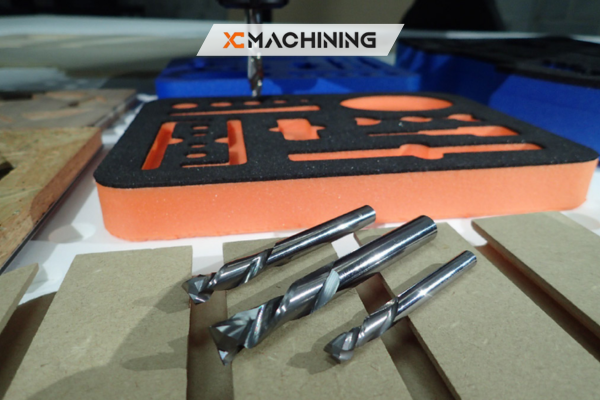
Economic Considerations in Tool Selection
While performance matters, economics ultimately drive tool selection decisions. Evaluating total cost per part rather than just tool purchase price provides accurate economic assessment.
Factors in economic analysis:
Initial tool cost: Purchase price varies dramatically $10 HSS drills versus $500 PCD end mills. Volume production justifies premium tools impossible to defend in prototype work.
Tool life: Durability determines replacement frequency. A $200 carbide end mill machining 500 parts before replacement costs $0.40 per part. A $50 HSS tool lasting 50 parts costs $1.00 per part—5 times higher despite lower purchase price.
Cycle time: Faster cutting speeds enabled by advanced tools reduce production time. In high-volume production, cycle time reductions often justify premium tooling through increased throughput.
Machining quality: Better tools reduce scrap rates and rework costs. Superior surface finish may eliminate secondary operations, providing savings beyond basic machining economics.
Flexibilité: Multi-purpose tools reduce inventory and setup time. Single-point thread mills cutting multiple thread sizes cost more initially but eliminate specialized tap inventory.
Emerging Trends in CNC Cutting Tools
Le CNC metal cutting machine tools market continues evolving with innovations enhancing capabilities:
Minimum quantity lubrication (MQL): Tools optimized for MQL deliver coolant through spindle directly to cutting zone, enabling near-dry machining with environmental and cost benefits.
Additive manufactured tools: 3D printing enables complex internal cooling channels and optimized geometries impossible with conventional manufacturing. Currently expensive but performance advantages continue expanding applications.
Smart tools: Sensors embedded in tools monitor temperature, vibration, and wear, enabling predictive maintenance and process optimization through data analytics.
Advanced coatings: New coating technologies extend capabilities—self-lubricating coatings reducing friction, multi-layer architectures optimizing multiple properties, and higher temperature resistance enabling faster speeds.
Conclusion
Choosing the right CNC cutting tools represents one of the most impactful decisions affecting machining success. The vast array of types of CNC cutting tools each optimized for specific materials, operations, and performance requirements provides solutions for virtually any machining challenge. Success requires understanding tool materials and their temperature capabilities, geometric parameters affecting cutting action, workpiece material characteristics and challenges, application-specific requirements for roughing versus finishing, and economic factors determining true cost-effectiveness.
The best cutting tools for CNC machining balance performance requirements against economic realities. Prototype and low-volume work justifies versatile general-purpose tooling, while high-volume production often demands specialized premium tools maximizing productivity. Between these extremes, most applications benefit from quality coated carbide tools offering excellent combinations of performance, versatility, and value.
As the CNC metal cutting machine tools market advances, tool technology continues evolving. Staying informed about innovations in materials, coatings, and geometries helps manufacturers maintain competitive advantages through improved productivity, extended tool life, and enhanced part quality. Ultimately, thoughtful tool selection—matching capabilities to requirements while considering economic realities separates efficient machining operations from those struggling with excessive costs, quality problems, and productivity limitations.
FAQ pour choisir les bons outils de découpe CNC
Quels sont les facteurs à prendre en compte lors du choix des outils de coupe CNC ?
Le type de matériau, la forme de l'opération (comme le fraisage ou le perçage), le type d'outil, la forme de la pièce, le matériau du revêtement et la flexibilité de la machine sont autant d'éléments à prendre en compte.
Quelle est la différence entre les fraises et les forets ?
Une fraise peut être utilisée dans plusieurs directions, alors que les perceuses sont destinées à percer des trous verticaux.
Pourquoi les outils de coupe en carbure sont-ils privilégiés ?
Le carbure étant résistant, dur et stable à haute température, ces outils de coupe conviennent parfaitement aux applications rapides et précises.
Comment puis-je prolonger la durée de vie de mes outils de coupe CNC ?
Utilisez les vitesses de coupe et les avances correctes, assurez un refroidissement efficace, planifiez des trajectoires d'outils efficaces et examinez et remplacez souvent vos outils usés.
Quel est le meilleur matériau d'outil pour couper des métaux durs ?
Presque toujours, le carbure est préféré pour les métaux durs ; ce n'est que lorsque les choses sont très difficiles que vous pouvez décider d'essayer des outils en céramique ou en CBN.

